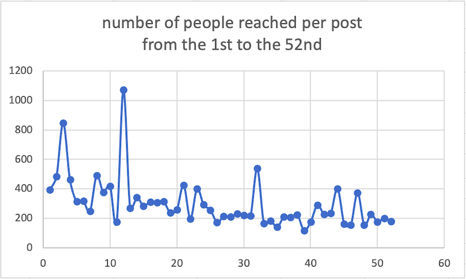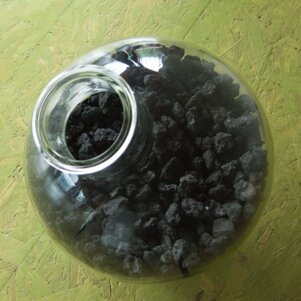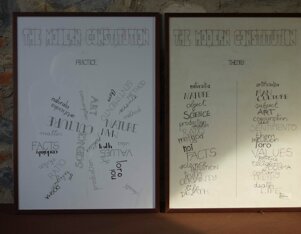postmaster@museumofanthropocenetechnology.org, via Leggiuno 32
2014 Laveno Mombello
Italia
FOR WHAT IT’S WORTH, an analysis of one year on Facebook
Between February 2021 and February 2022 the Museum published every week a work from its collection on Facebook. It started during one of the COVID lockdowns; when people could not come to the Museum, the Museum went to the people.
52 works, of which 16 made by friends artists and the remainder by the Museum itself, signed “MAT”.
A work is given meaning not only by its creator but also by the public that interacts with it. (That explains why the works made by Frank Raes, founder of the Museum, are signed “MAT”.) During real guided visits to the Museum, visitors usually interact well and discucs. In principle, Facebook offers an excellent technology for exchanging ideas about a published work with virtual visitors. However, in our case, that didn't turn out very successful as most comments stayed at a rather superficial level. Only one visitor regularly commented and went into a discussion about the possible meaning of the works.
The works were published on the page of the Museum (110 followers) and systematically shared on the personal page of Frank Raes (1030 followers). Facebook reveals for each post the number of people reached (R) and the number of interactions with the post (I) (e.g.: likes, comments, shares, …). Having this information available it is tempting to do an analysis, for the mere pleasure of doing so, and, for what it is worth, to try and rank the works.
Ranking according to the number of people reached (R) after de-trending.
The number of people reached (R) by a particular post is decided by the Facebook algorithm. We don't know how that exactly works, but it probably depends on the number of reaches and interactions of previous posts, on the number of interactions that the Museum or Frank Raes just had with other people, the day and hour the post is published, etc … Figure 1a shows the number of people reached for each post as they were published during the year.


Figure 1a
Figure 1a
Figure 1b
Figure 1b
There is a downward trend during the first 6 months, which shows that Facebook lost interest in the posts, and eventually decided to send the post only to about 225 people on average. There are however works that clearly score higher than this average trend. A ranking based on the number of people reached makes sense, but only after de-trending these numbers in order not to penalise works that were published in the second part of the year. The result of the de-trending is shown in Figure 1b. The ranking based on these de-trended values is shown in Table 1 below, in which we show only the top 15 works.

Table 1
Table 1
Figure 2 below shows the top 9 works according to this ranking. (Nine, because they nicely fit into a 3x3 square)



Nr. 31 - SILENT SUN2019, Matteo Pizzolante
Nr. 31 - SILENT SUN
Nr. e15 - BRANCUSI I2013-14, MAT
Nr. e15 - BRANCUSI I
2019, Matteo Pizzolante
2013-14, MAT


Nr. 2 - GLASSES MADE IN P.R.C.
Nr. 2 - GLASSES MADE IN P.R.C.

Nr. e19 - IDEAL AND REAL2020, MAT / Anais Tondeur / Renate Quenberger
Nr. e19 - IDEAL AND REAL
2020, MAT / Anais Tondeur / Renate Quenberger
Nr. 67 - WHITE CLOUD2019, MAT
Nr. 67 - WHITE CLOUD
2019, MAT


Nr. 10 - LO SQUARCIO I2017, Fabio Castelli / MAT
Nr. 10 - LO SQUARCIO I

Nr. 13 - SILENT SPRING2018, MAT
Nr. 13 - SILENT SPRING
2018, MAT
Nr. 8 - COAL
Nr. 8 - COAL
Ranking according to the ratio of the number of interactions over the number of people reached (I/R)
The number of interactions (I) with each post might also be an indicator of appreciation for the work. The ratio of the number of interactions over the number of people reached (I/R) might even be better because it gets rid of the problem of trends and reveals a kind of "intensity" of interaction that the work stimulates among the public The ranking based on I/R is shown in Table 2 below, with again the top 15 works listed.

Table 2
Table 2
Figure 3 below shows the top 9 works according to this ranking. 7 works are new, compared to Figure 2.




Nr. 38 - EVERYTHING FOR YOU MOMBELLO2017, Jan De Cock
Nr. 38 - EVERYTHING FOR YOU MOMBELLO
FOSSIL IIIb2020, MAT
FOSSIL IIIb
2017, Jan De Cock
2020, MAT


Nr. e29 - WO(/+MAN2022, MAT
Nr. e29 - WO(/+MAN
2022, MAT
Nr. 96 - M.Y. NEW YORK2020, MAT
Nr. 96 - M.Y. NEW YORK
2020, MAT


Nr. 125 - MICKYMOUSIAN2021, MAT
Nr. 125 - MICKYMOUSIAN
2021, MAT

Nr. 8 - COAL300 Mio yrs BCE
Nr. 8 - COAL
Nr. 45 - THE MAZE2015, Jan Raes, JRC, MAT
Nr. 45 - THE MAZE
300 Mio yrs BCE
Nr. 67 - WHITE CLOUD2019, MAT
Nr. 67 - WHITE CLOUD
2015, Jan Raes, JRC, MAT
2019, MAT
Note. It is kind of funny that the secondly ranked and the lastly ranked according to I/R are works by two well known Belgian artists. That might show that our exercise is nonsensical. However, there is an important difference between the two: Jan De Cock (rank 2) is still alive and kicking (look here for a description of the Museum’s interaction with the master sculptor), but Panamarenko (rank 52), died in 2019. Panamarenko is much loved by the Museum, and his poor performance here hurts a bit. We have to admit, however, that the Museum only holds a (well-done) facsimile of the artist’s work (see Cat. Nr. 99)
Final Ranking, based on the sum of the above two rankings.
In Table 3 we ranked the works according to the sum of their rankings in Tables 1 and 2. In this way we see which works feature high in both rankings. New works appear in the top 15. We believe that this final ranking gives the best possible idea about which works are appreciated by our jury of 200 to 1000 people (we cannot be more precise). We list the top 15 as well as the bottom 15.


Figure 4 below shows the top 9 works according to this final ranking. 2 works are new compared to Figures 2 and 3.



Nr. e5 - ESCAPE I2019, MAT
Nr. e5 - ESCAPE I
Nr. 67 - WHITE CLOUD2019, MAT
Nr. 67 - WHITE CLOUD
Nr. 8 - COAL300 Mio yrs BCE
Nr. 8 - COAL
2019, MAT
2019, MAT
300 Mio yrs BCE



Nr. 13 - SILENT SPRING2018, MAT
Nr. 13 - SILENT SPRING
2018, MAT

Nr. 38 - EVERYTHING FOR YOU MOMBELLO2017, Jan De Cock
Nr. 38 - EVERYTHING FOR YOU MOMBELLO
Nr. 78 - DATAMI2018, MAT
Nr. 78 - DATAMI
2017, Jan De Cock
2018, MAT


Nt. 45 - THE MAZE OF KNOWLEDGE2015, Jan Raes, JRC, MAT
Nt. 45 - THE MAZE OF KNOWLEDGE
2015, Jan Raes, JRC, MAT
Nr. e26 - C6H12O6 and O@C122019, MAT
Nr. e26 - C6H12O6 and O@C12
2019, MAT
THE IDEAL AND THE REAL2020, MAT / Anais Tondeur / Renate Quenberger
THE IDEAL AND THE REAL
2020, MAT / Anais Tondeur / Renate Quenberger
Figure 5 below shows the bottom 9 works according to the final ranking.



Nr. 48 - THE MODERN CONSTITUTION2018, MAT
Nr. 48 - THE MODERN CONSTITUTION
2018, MAT
Nr. e17 - SMARTPHONE 1960ies2019, MAT
Nr. e17 - SMARTPHONE 1960ies
Nr. 88 - FISH (?) ALUMINUM2018, MAT
Nr. 88 - FISH (?) ALUMINUM

2019, MAT
2018, MAT


Nr. 112 - SUNSET OVER ENI2020, MAT
Nr. 112 - SUNSET OVER ENI
2020, MAT
Nr. 19 - EUDOSSIA2018, Frank Raes
Nr. 19 - EUDOSSIA
2018, Frank Raes


Nr. 49 THE BERLIN WALL1989, Guy Le Querrec
Nr. 49 THE BERLIN WALL
1989, Guy Le Querrec

Nr. 101 - PANAMA2003 - Panamarenko (and R. Vand de Velde)
Nr. 101 - PANAMA
2003 - Panamarenko (and R. Vand de Velde)
Nr. 68 - MOEBIAN STRIP2019, MAT
Nr. 68 - MOEBIAN STRIP
2019, MAT
Nr. 90 - THE SUN2020, NASA
Nr. 90 - THE SUN
2020, NASA
Conclusions? For what they are worth.
The Museum did not go viral :-)
The rankings clearly have to be taken with a big grain of salt. Two very similar works, Cat Nr. 88 and Cat. Nr. 89, finished in all three rankings with about 10 positions apart. That might indicate that works ranked within an interval of 10 positions could still be considered ex-equo. In other words, the top ten works would all be first, the next ten works all second, etc.
Anyway, if we look at the final ranking (Table 3), we see that in the bottom 15 there are 7 works that in their descriptions rather explicitly refer to the philosophical basis of the Museum: its attempt to find ways of going beyond modern dualistic thinking. In the top 15 we find only 2 such works. Many of the works in the top 15 anyway do refer to dualisms etc. , but they do it rather implicitly, by which we mean: in a more visual rather than descriptive manner. (Visuals are of course important on a platform like Facebook ...)
Will this analysis change the way the Museum acquires or makes its works? Giving the wishy washy nature of the results, most probably not. So far the Museum acquired and made works in a very intuitive way: one work brought along the next, serendipity was at work most of the time. Giving meaning to the works usually came later, and was often done together with the visitors, within the mentioned philosophical framework.
The exercise might only confirm that starting from a well developed theory or philosophy, is a bad recipe for making appealing and telling works. Even Picasso got in the trap of making art to express some idea (an ideology in fact: communism) and it resulted in its worst works.
So, at the Museum we will keep messing around, hoping to get beyond Modernity.
postmaster@museumofanthropocenetechnology.org, via Leggiuno 32
Laveno Mombello
21014
Italia